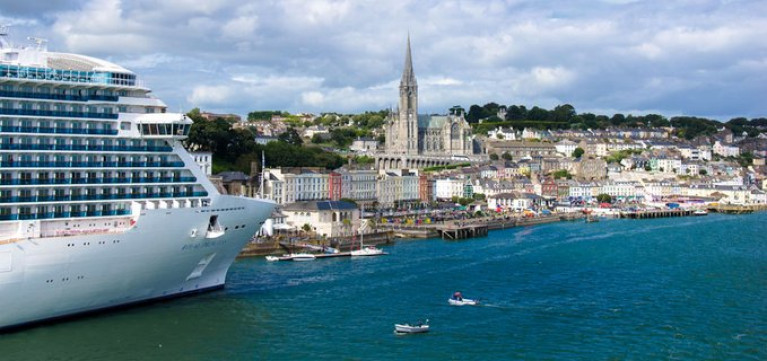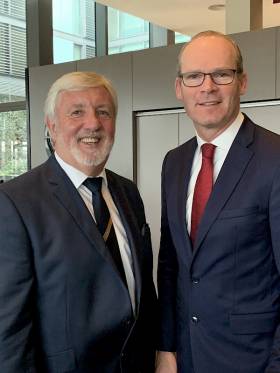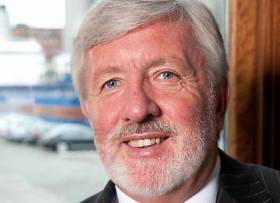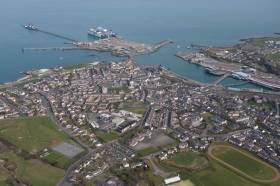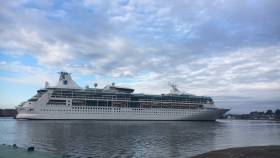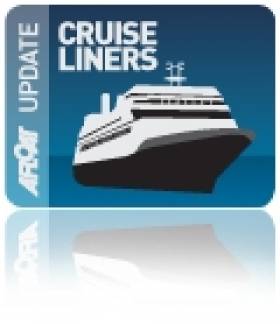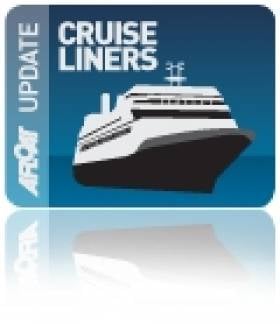Displaying items by tag: Cruise Europe
Cruise Europe Celebrates 30 Years of Sea Change in the Industry
Industry body Cruise Europe is looking back over 30 years of development and growth since its formation in 1991.
The idea for network to promote cruises in Northern Europe was first suggested during the Seatrade Cruise Shipping Convention and Exhibition in Miami in March 1990.
The following year a working party — drawn from the ports of Bergen and Oslo in Norway, Ghent in Belgium, Rouen in France, Tilbury in England, Cromarty Firth in eastern Scotland and Cork in Ireland — distributed a business prospectus to potential members under the working title of the North European Ports Co-Operative.
At the time the idea was to encourage more cruise visits to the area and extend the season beyond the month of June, July and August.
In December 1991 in Copenhagen, the fledgling group was formally constituted at an EGM where 21 port members joined together under the title of Cruise Europe.
The official launch would take place at the next Seatrade Cruise Convention in Miami, where Tim Harris, then CEO of P&O Cruises, commented that over the next decade cruising would become a truly worldwide industry.
His prediction would prove to be correct, as within a year Costa Cruises began dipping its toes in the Northern European market. By 1996, the region had caught the attention of Royal Caribbean whose Splendour of the Seas was home-ported in Harwich in Eessex.
At Cruise Europe’s AGM in Le Havre in 2013, cruise analyst Peter Wild stated that the European source market reached 6.2 million out of the world total of 20.6 million in 2012 — a remarkable achievement just 12 years after the idea was first floated.
The year 2012 also saw the election of Michael McCarthy — formerly of the Port of Cork — as chair of Cruise Europe. It’s a post he still holds today, and he is looking forward to the future after the recent challenges of COVID-19.
“Nobody can articulate the impact of the current pandemic on the cruise industry with catastrophic losses, downsizing of fleets, the removal of ‘older’ ships, and future capacity being moderated by the phased re-entry of ships and delays in new ship deliveries,” he says.
“However, the cruise industry is resilient and CE will continue to partner with the cruise lines, modernise our way of communication, strengthen and improve our media work and increase the activity of regional meetings.
“Full cruise ships will sail again and CE will continue to play a leading role in keeping abreast of environmental and sustainability issues in tackling climate change and the ‘greening’ of the industry.”
According to Cruise Europe (CE), the role of organisations and associations, such as CE, is now more critical than ever commented Michael McCarthy, chairman of Cruise Europe on the Covid-19 pandemic.
“Over the last four years the executive of [Cruise Lines International Association] CLIA Europe has engaged with these associations in a very proactive way which will work to all our benefit during this unprecedented and catastrophic pandemic for so many in society as well as business. It is life changing in many ways.
“The rapidly-spreading virus has caused uncertainty and vulnerability in every society in every country and the World Health Organization (WHO) and their best medical staff are scrambling to understand the virus and trying to catch up with its meteoritic spread. The tourism sector has never before in my lifetime been impacted so heavily and so comprehensively.”
All ports are keeping their contingency plans under review while dealing with the unfolding developments. At this time all members are advised to keep under review the European Commission ‘Guidelines on protection of health, repatriation and travel arrangements for seafarers, passengers and other persons on board ships’, which are on the EU website.
“Clearly this global crisis will change us and what we do and what I would like to convey is that it is our inter-dependence as an industry that has made us develop and kept us strong for so long. It is these dependencies and connectivity that will help us emerge from this together,” says McCarthy.
The WHO is the driver of policy in tackling the pandemic and its criteria and guidance will determine what restrictions, protocols and practices need to be enforced to help ensure the health and well-being of passengers and crew.
CE and the cruiselines are passionate and committed to the safety of its passengers and crew. “It will be our challenge going forward to bring that message to the public along with responsible tourism practices and the highest standards of environmental stewardship.”
All CE ports are covered by the IMO-Maritime Declaration of Health which has to be completed and submitted to the competent authorities by the masters of ships arriving from foreign ports. Some of the health questions in this Declaration include being aware of any condition on board which may lead to infection or spread of disease, quarantine, isolation, disinfection or decontamination. In the absence of a surgeon, the master has to regard symptoms as grounds for suspecting the existence of a disease/virus of an infectious nature. In addition, all countries are parties to the WHO International Health Regulations pertaining to International voyages.
Prior to the current pandemic, the cruise industry was one of the fastest growing segments of tourism. Many destination business models were under review and improvements in infrastructure and on the sustainability of the sector were being carried out. This ‘sustainability’ included fuel emissions, EGCS, washwater, smoke, port waste reception facilities, ballast water management, LNG, GHG, number of cruise ships in port, over-tourism, overcrowding, traffic, noise, etc.
To avoid perception becoming reality, the industry and its stakeholders need to find a solution to answer the many fears and concerns of ports and regions accepting large cruiseships berthing in densely populated areas. This will have to include health monitoring in line with security monitoring if passengers are to feel welcomed to a region rather than be shunned. This will also apply to all tourism as people return to air, sea, bus and rail transport.
“With industries across the globe shut down, this pandemic has exposed the very nature and vulnerability of the worlds current supply chain and the way people live. I have no doubt that a recovery will come and we will be stronger and better. CE members are dealing with the present while reacting by looking at options and potential opportunities. This may entail new strategies for the future of their business. The important point is to be ready for the recovery because there are many things that can be done now that will be successful no matter what the future conditions.”
CruiseEurope adds that a longer version of this article first appeared on the CruiseNews Media Group website on 6 April.
Cruise Europe Summit in Dublin Highlights Uncertainty Over Brexit
#cruiseliners - A Cruise Europe summit hosted by Dublin Port Company to discuss Brexit by members of the cruise association that promotes destinations in Northern and Atlantic Europe was recently held in the Irish capital.
Attending the summit was Simon Coveney, An Tanaiste and Minister for Foreign Affairs and Trade, who opened proceedings by updating members on the uncertainty that continues to prevail over Brexit. The Minister went on to state that this is not just a British issue but will have an effect on many other EU states.
This uncertainty is proving to be challenging for governments and business alike. The Minister acknowledged the economic benefit of the tourism and maritime sectors and reiterated the government commitment to supporting these industries and the development of cruise tourism going forward.
According to Cruise Europe, panellists agreed that the uncertainty that remains is bad for business. All organisations are spending time and resources on contingency planning rather than developing growth strategies. While current cruise bookings remain buoyant and there are no immediate plans to change itineraries, the main concern is the stability of sterling and the potential economic impact thereof.
The movement of passengers and stores remains under review. However, cruise companies do not anticipate that there will be a significant impact at this time. Cruise operators did request that ports relay any information in relation to local customs and immigration decisions that may be useful in the planning process.
Panellists attending the summit at the Gibson Hotel, Dublin, included executives from Carnival UK, Fred Olsen Cruise Lines, Royal Caribbean Cruises and Cruise & Maritime Voyages as well as representatives from Irish state agencies, port authorities, shipping agents and shore excursion providers.
Next month, Afloat adds will be Cruise Europe's annual Cruise Conference which is to be held in Zeebrugge, Belgium between 4-7 March.
Cruise Europe's Update from Chairman on Blue Port Project
#CruiseLiners - It was at Cruise Europe's AGM in St Petersburg during April, when chairman Captain Michael McCarthy outlined how it would be in the interests of CE as an organisation to retain an 'Observer and Contributor Status' to the Atlantic Blue Ports EU project.
The aim is to contribute to the many important environmental challenges facing the cruise industry and ports through port reception facilities (PRF) for ballast, oily waste and scrubber waste from exhaust gas cleaning systems, in many cases retrofitted to many vessels.
Designing and investing in 'ideal' port reception and treatment facilities requires immediate regional and trans-national government support as the demand is growing for such port services including scrubber waste, hydrocarbon waste and ballast waters.
ISSUES UNDER THE BLUE PORT PROJECT
SULPHUR DIRECTIVE
The amended Sulphur Directive (SD) required that member states took measures to ensure that the sulphur content of marine fuels used in Sulphur Emission Control Areas (SECAs) does not exceed 0.10% as from January 1 2015. However, the SD provides that member states should allow the application of alternative SOx emission abatement techniques. One of these is the use of exhaust gas cleaning systems (EGCS), known as scrubbers.
In a nutshell, this involves cleaning the engine exhaust with water and discharging the wash water either to the sea (open-loop scrubbers) or to port facilities (closed-loop scrubbers). The text of the SD requires that scrubbers comply with an IMO standard (2) which sets certain minimum performance values for the washwater.
However, a debate had arisen as to the effect of the SD provisions concerning the use of scrubbers vis-à-vis WFD (Water Framework Directive) obligations. For example, some of the pollutants reported in the washwater are polyaromatic hydrocarbons (PAHs), which are priority hazardous substances under the WFD.
The SD makes no reference to the WFD and vice versa. The two directives pursue different but complementary objectives: one relates to reducing emissions of SOx, while the other inter alia relates to protecting and improving the aquatic environment. The WFD's objectives include the prevention of deterioration and the achievement of good chemical status.
The primary intention of the SD is to encourage the use of low-sulphur fuel in maritime transport and this involves a considerable investment in new or retrofitted engine technology by ship owners. The SD permits the use of scrubbers as an alternative means of achieving its objective on SOx emissions.
However, the possibility of allowing the use of scrubbers does not prevail over European Union (EU) legislation to safeguard Europe's waters. In other words, the SD does not add a new exemption to the binding environmental objectives of the WFD which have to be met by national authorities. Therefore, when applying the provisions of the SD which permit the use of scrubbers under the conditions specified by the International Maritime Organization (IMO), WFD obligations remain applicable in relation to water quality and the progressive reduction/phase-out of pollutant emissions.
In that context, the national authorities are best placed to determine whether the operation of scrubbers is likely to affect the achievement of WFD objectives, and to take appropriate measures. From the available information, it appears that the majority of the SECAs bordering member states have not yet decided on possibly limiting the discharge of scrubber washwater beyond the IMO standard to ensure compatibility with the WFD.
This legal uncertainty may affect the use of already installed and approved scrubbers, and possibly complicate future investment decisions of shipowners. Under the European Sustainable Shipping Forum (ESSF) 5, it was decided to collect more information about the exact characteristics of the scrubber washwater from shipowners already using this abatement equipment on board. This should provide more information concerning the use of scrubbers vis-à-vis WFD obligations.
The SD permits the use of scrubbers under the conditions specified by the IMO as a possible means of compliance with the 0.10% sulphur in fuel requirement that entered into force on January 1 2015 for ships operating in the EU SECAs and for ships at berth in all EU ports.
At the same time, the recitals of the 2012 amendment of the SD and the associated Impact Assessment make it clear that the use of scrubbers needs to be compatible with the EU's broader environmental protection objectives, notably those in relation to the protection of the marine ecosystem and that their use should not lead to a transfer of the pollution problem from air to water. Hence the use of scrubbers in EU waters, including the discharge of washwater, must not hamper any EU coastal state from complying with the binding obligations set in the WFD.
The commission believes that at this stage it is still uncertain as to what extent the discharge of scrubber washwater would jeopardise compliance with the WFD obligations. However, it is reported that there is increasing evidence from recent studies and analyses of washwater samples of existing scrubbers that the washwater contains PAHs and heavy metals (eg vanadium, zinc, cadmium, lead and nickel) in potentially larger quantities than initially thought. In this context it should also be recognised that the IMO Exhaust Gas Cleaning System guidelines do not contain any detailed discharge requirements as regards suspended particulate matter, including heavy metals and ash, rather a general obligation 'to minimise' these pollutants.
The commission believes that while the number of existing ships currently equipped with scrubbers is not likely to substantially affect the achievement of the status objectives of the WFD, the likely future increase in the number of ships equipped with scrubbers in view of the entry-into-force of the 2020 0.5% sulphur cap, their possible concentration in certain sensitive sea areas (eg ports and estuaries) and the cumulative effect of the washwater discharge, do require a precautionary approach which should be considered in the forward-looking parts of the River Basin Management Plans and 'programmes of measures'.
Every port is unique (river estuaries, closed/open docks, amount of ships, type of ships, amount of ships with scrubbers) and a common approach might be hard to find. The absence of harmonised rules in Europe might distort the market for ports (ports with more stringent regulations).
In case a demonstrated need arises in the future, the discharge of washwater may be restricted in selected areas (ie ports) to comply with the objectives of the WFD. The process will be coordinated between the relevant authorities (environment, maritime and transport). Possible restrictions should seek not to punish early movers.
It does not make real sense to purify sulphur from exhaust gas in order to achieve cleaner air and then directly release sulphur into surface water. Discharging of scrubber washwater into surface water should be considered in the same way as discharging wastewater into surface water - it has to be treated to conform within the set limit values of pollutants before discharging into surface water. Dilution is not a solution.
During 2018, Cruise Europe member ports were contacted and feedback requested on the regulations related to use of open-loop scrubbers in their ports. Are their water quality levels, and control processes, defined and if so, is it at international/national or local level? The general feedback from CE members varied from country to country with the following replies:
-Open-loop scrubbers are allowed in a large number of ports
-However, some individual ports recommend/instruct shipowners to use closed-loop scrubbers, but so far have not made this mandatory
-Many ports are carrying out sediment cleanup operation in the main cruise quay area which may lead to more strict requirements regarding scrubber washwater
-German regulations do not allow open-loop scrubber systems in their river ports. Ships are only allowed to use the closed-loop system with a buffer tank, which may only be emptied at sea
-Some ports have a bonus system on harbour dues for environmentally-friendly ships as they try to promote ships to use cleaner engines and fuels
-Some ports prohibit the discharge of exhaust gas scrubber washwater, enacted under the WFD Habitats Directive (Directive 92/43/EEC) & Water Framework Directive
BALLAST WATER MANAGEMENT CONVENTION
The International Convention for the Control and Management of Ships’ Ballast Water and Sediments (BWM Convention - Ballast Water Management) entered into force on September 8 2017.
Adopted by the IMO in 2004, the measure for environmental protection aims to stop the spread of potentially invasive aquatic species in ships ballast water and requires vessels to manage their ballast water to remove, render harmless, or avoid the uptake or discharge of aquatic organisms and pathogens within ballast water and sediments. Initially, there will be two different standards, corresponding to these two options.
The D-1 standard requires ships to exchange their ballast water in open seas, away from coastal waters. Ideally, this means at least 200nm from land and in water at least 200m deep.
The D-1 Standard will continue to 2022 and must:
-Comply to D-2 Standard by 2022
-Or the 2nd Renewal of the International Oil Pollution Prevention (IOPP) certificate which is valid for five years.
D-2 is a performance standard which specifies the maximum amount of viable organisms allowed to be discharged, including specified indicator microbes harmful to human health.
New ships must meet the D-2 standard from September 8 2017 while existing ships must initially meet the D-1 standard. An implementation timetable for the D-2 standard has been agreed, based on the date of the ship’s IOPP certificate renewal survey, which must be undertaken at least every five years.
Eventually, all ships will have to conform to the D-2 standard. For most ships, this involves installing special equipment approved by national authorities, according to a process developed by IMO. Systems have to be tested in a landbased facility and on board ships to prove that they meet the performance standard set out in the treaty. These could, for example, include systems which make use of filters and ultraviolet light or electro chlorination.
To date, more than 60 ballast water treatment systems have been given type approval and as of September 2017, the treaty has been ratified by more than 60 countries, representing more than 70% of world merchant shipping tonnage. However, shipowners are asking which system they should buy, that it is fully compliant during Port State Control inspection and will it pass the more stringent United States approval regime for treatment equipment which requires all ships that discharge ballast water in US waters to use a treatment system approved by the US Coast Guard (USCG).
However, because no systems have yet been approved, ships already required to comply with the US regulations have either been granted extensions to the dates for fitting the required treatment systems or else permitted to install a USCG accepted Alternate Management System (AMS), in practice a system type-approved in accordance with the current IMO guidelines.
This impasse in the US is a particular concern for operators that have installed ultraviolet (UV) systems with the International Chamber of Shipping saying that the situation has been compounded by the USCG announcing, at the end of last year, that it will not accept the methodology used by other IMO member states to approve UV treatment systems when assessing the number of viable organisms in treated ballast water.
ESPO PUBLISHED ITS POSITION PAPER ON THE PRFs FOR SHIP WASTE (May 9 2018)
For European ports, ship waste has been one of the main environmental priorities, as indicated in the European Sea Ports Organisation (ESPO) 2017 Sustainability Report. In its position paper on the revision of the Port Reception Facilities (PRFs) directive, ESPO welcomed the commission proposal and its objective to build upon the substantial progress achieved under the existing directive.
European ports support, in particular, the proposal’s objectives to increase efficiency and reduce administrative burden. The new directive also makes sure that efficient but responsible regime for managing ship waste is encouraged, in line with the ‘polluter pays’ principle.
“European ports recognise that providing the right incentives is essential and port authorities are certainly willing to contribute. However, introducing a fee system whereby ships could deliver unreasonable amounts of garbage, including dangerous waste for 100% fixed fee, would be a severe and unacceptable divergence from the ‘polluter pays’ principle. It risks to discourage tackling waste at the source by reducing waste volumes on board, which has been the cornerstone of the EU waste policy,” says ESPO’s secretary general Isabelle Ryckbost.
ESPO therefore proposes to set a limit on waste covered by the 100% fixed fee. The fixed (flat) fee should cover normal quantities of waste delivered by a certain type and size of ship. Ports should be allowed to charge on top of that if unreasonable quantities are delivered. Furthermore, dangerous waste, which usually needs special and costly treatment, should not be covered by the 100% indirect fee. European ports believe, moreover, that any provisions leading to better enforcement of the obligation for ships to deliver waste at shore are welcome. The alignment of specific elements of the directive with the International Convention for the Prevention of Pollution from Ships (MARPOL) is supported by ESPO. European ports also welcome that new types of waste, such as scrubber waste, have been addressed by the proposal.
SUMMARY
In a recent presentation at the Cruise Summit in Madrid, Ms E Mallach of ASD-Law gave a very interesting paper on ‘Cruising to Sustainability’.
She highlighted and summarised many of the issues and challenges:
-The pollution challenge involves climate change at the end of a chain of environmental challenges including air and water pollution through gases and waste
- In April 2018, IMO Marine Environmental Protection Committee adopted a strategy to reduce greenhouse gas emissions from shipping by at least 50% by 2050
-The legal framework on compliant fuels, EGCS/scrubbers, LNG and fuel cells.
The demand is continuing to grow for PRFs worldwide and this project, @BluePorts, addresses an important environmental challenge. The essence of this project is to identify solutions and ‘hardware’ that can be utilised in tackling the discharge of ‘harmful substances’ into our oceans. In order to achieve this we need to motivate the maritime community to stop discharge at sea. We can do this by designing in consensus to the Blue Port Services for 2020 and beyond. Very often perception is reality and, in particular, as the word ‘sustainability' is on every persons mind.
There is no doubt that the cruiselines are 'ahead of the curve' and often go beyond compliance when it comes to ship and fuel technology. They are the leaders in the field on newbuilding technology and innovation, ship designs and environmental advances. We often hear the words 'clean ships in clean ports’. This emphasises the great work being done but cruising is paying the price for its visibility.
We see that every day and it highlights the importance of handling the many issues in a coordinative and cooperative way to ensure the ‘sustainability' of the cruise sector. Cruiseships can only survive in a clean environment as they visit splendid locations throughout the world, including many World Heritage sites, and this highlights the importance of keeping those locations 'splendid'.
These often-quoted words sum up the Blue Port project: “The sea is our greatest asset, the sea is our home”..…
Cruise Europe Chairman Captain Alters Course
#CruiseChairman - Captain Michael McCarthy chairman of Cruise Europe (CE) has retired from his position as commercial manager with the Port of Cork Company last month but, as those of us who know him are well aware, this does not mean he will be getting out his pipe and slippers.
As Cruise Europe adds he has stepped down from his well-established role in the shipping industry: just altering course a little. And Cork will still be very much on his radar.
Starting his sea life as a cadet for Irish Shipping Ltd in 1971, he rose to being master in 1982 spending 13 years travelling the high seas worldwide. He is a strong advocate of a life at sea, saying: “Running a ship in such often adverse conditions gives any young person an opportunity to learn and demonstrate organisational, motivational, collaborative and leadership skills.”
In 1984 he moved shoreside taking on the role of director/surveyor with marine cargo and insurance surveyors, Sea Service Ltd, and in 1991 he took on the role of deputy harbour master and deputy superintendent of pilots at the Port of Cork and Port of Bantry. McCarthy expanded his shoreside learning while studying marketing and management at University College Cork and, in 2007, was appointed commercial manager for the port. This role really suited Michael as it gave him an opportunity to define developments and strategy, building sustainable relationships and new trade routes while consolidating and growing Cork’s position in the cruise sector.
His career has given him a wealth of knowledge into the whys and wherefores of the shipping industry and, most importantly for CE, the cruise sector. Over the years he has taken on many additional roles including president of the Irish Institute of Master Marines, Irish representative to the International Federation of Ship Masters and chairman of Cobh Seas Scouts as well as active ventures leader.
McCarthy is now ready for a new challenge as a marine consultant for his newly-established company MMCC Port Marine Ltd. In the first instance, he has already been taken on as a consultant by the Port of Cork until the end of 2020. He will be advising on the cruise sector, his successor and potential new infrastructure. In addition a number of CE members have requested his assistance in reviewing their cruise propositions.
Cruise Europe’s gain is that McCarthy will be able to devote even more time to developing the association together with CE managing director, Jens Skrede. This is at a time when the industry is moving into yet another growth phase with all the implications, in terms of infrastructure and regulations, that this involves. He is a great advocate of collaboration and strives to bring the various organisations and associations closer together in this very exciting and yet challenging sector.
High on the list is the creation of a unified environmental response from all sides of the industry, including associations such as CE and Cruise Lines International Association, to be available for those countering resistance in their communities. This would help increase public awareness of just how much is being done to minimise pollution both at sea and in port. McCarthy says he is hopeful that these issues will be on the agenda at Seatrade Med in Lisbon in September.
#CruiseHolyhead - The Port of Holyhead in north Wales will according to Cruise Europe welcome 34% more passengers in 2018 than this year, bringing the total to 36,000 on 43 calls.
The jetty, which is owned by Stena Line but operated by Orthios, presently takes vessels up to 310m in length. However Suzanne Thomas, head of Cruise Wales, told CE that a new multi-use berth development is being considered. It will be 340m long and hence able to accommodate vessels up to 365m in length.
“Royal Caribbean is advising us on the build and the channels and all the technical aspects with regard to the Oasis class. We are hoping it will be ready for 2020. All the stakeholders, including Stena, are still discussing the investment,” she explained.
There is also an anchorage facility which can take any size of vessel. Tenders take four minutes to arrive at the marina in Holyhead.
Every ship is greeted by a choir, a singer or Welsh dancers with many also requesting the entertainment to go on board prior to departure. When a German vessel arrives, ambassadors who speak German are part of the welcome on the jetty, in the shuttles, stationed throughout the town, and take part in Blue Badge tours. When the first call went out 220 Germans living in North Wales applied for the 50 posts. A new training programme to increase numbers is being considered.
In Holyhead cruiseship days are not just for the passengers. Thomas said: “We like to make sure that the local community are involved where possible with the local activities provided. We don’t just have activities on the jetty but a band in the town centre and a local craft market where the booths are provided free for the day. As the passengers come off the ship we give them maps, advice on transport and pamphlets on what is going on, for example three choir performances a day in the church.”
At present there is a project taking place with Royal Caribbean to set up training for hospitality students in a local college. This has already been done with Seabourn whereby the students undertook a couple of contracts at sea and then returned to work on shore with the skills they have learnt.
Fam trips, a cruise conference in 2018 and new tours are all under consideration. The latter are offered direct to the lines rather than to the tour operators. One example is to take the longest zipline in Europe which goes over a quarry.
'Atlantic Europe' New Name Given to Serve Cruise Region Ports Under Single Umbrella Group
#cruiseliners - Atlantic Europe is the new name being given to serve the Cruise Europe region following a joint announcement made during Seatrade Europe in Hamburg, Germany.
The announcement by Cruise Europe (CE) and the Atlantic Alliance (AA) follows a decision that the member ports will be better served under one umbrella.
Atlantic Europe will now represent the region which encompasses 30 ports, including the 14 from AA, which extends from Lisbon to Hamburg along the western coast of Europe.
Chairman of CE, Michael McCarthy comments: “As itinerary planning in Europe constantly moves between regions, it is vital that a consistency of message and product delivery is offered to the cruiselines. The Cruise Europe management team work in partnership with all the regions in delivering that clear message and we welcome the opportunity of working with all our members in the Atlantic Europe region to further strengthen such a vital area.”
Traditionally ports within this region have been included in repositioning voyages (and still are) but proactive marketing by the two associations, and the ports themselves, has led to cruiselines sailing itineraries within the region itself. Atlantic Europe has come of age.
AIDA Cruises’ AIDAprima has been a major bonus in terms of highlighting the region. Sailing year-round out of Hamburg following her christening in 2016, she calls Le Havre, Zeebrugge and Rotterdam (as well as Southampton). This year P&O Cruises is offering an itinerary out of Southampton to La Coruna, Bilbao, La Rochelle and Cherbourg.
However it was Costa Cruises which began the trend back in 2011 when it began partial turnarounds in Le Havre on its ‘seven capitals’ itineraries. Whilst the ports included extended beyond Atlantic Europe, it was a sea-change in thinking and the start of a different way of seeing the region. In addition ‘interporting’ became a familiar word in the cruise dictionary.
The following year the Italian brand offered a similar itinerary for three months beginning in May. At this point Princess Cruises with Caribbean Princess and Royal Caribbean International with Brilliance of the Seas followed suit, each sailing a few itineraries. In 2013 MSC Opera sailed itineraries from Le Havre which included Lisbon, Vigo, Bilbao, and Ijmuiden while Princess offered voyages on Caribbean Princess. In 2014, MSC Opera and MSC Magnifica sailed the region as did Ruby Princess.
Fast forward to 2018 and we find MSC Cruises and Costa Cruises offering round-trip itineraries from Le Havre: MSC Magnifica on roughly 18 to include ports such as Lisbon, Bilbao, Zeebrugge, Amsterdam and Hamburg. Meanwhile Costa Cruises is due to sail a trio which includes Hamburg, Bremerhaven, Zeebrugge and Amsterdam.
The southern part of AE has also benefited although itineraries from here tend to extend beyond the AE borders. In 2009 Vigo joined the interporting/baseport circuit. The first was a one-off from MSC Cruises as MSC Splendida emerged from construction at STX France and sailed to Barcelona for the official launch, picking up passengers in Vigo.
A year later Iberocruceros sailed a number of itineraries on Grand Voyager out of the Spanish port, one of which encompassed AE in terms of a roundtrip to La Rochelle. In 2011 Iberocruceros sailed a couple of AE voyages out of Vigo which included calls at Zeebrugge, Amsterdam and Le Havre. In 2012, Grand Mistral replaced Voyager, sailing a southbound route which included Lisbon and MSC returned with MSC Opera sailing northbound to Bilbao, Zeebrugge and beyond. The latter then sailed for two years on an itinerary which included Lisbon, Vigo, Bilbao, Le Havre and Ijmuiden. Pullmantur joined the scene in 2016 with just one cruise a year sailing north in the AE and beyond. Next year the Zenith itinerary includes Lisbon, Cherbourg and Ijmuiden.
Atlantic Europe is a region encompassing Portugal, Spain, France, Belgium, The Netherlands and Germany. It includes ports of varying sizes which means that there is something for every cruiseline and every type of ship whether small, luxury, large or premium.
From a destination point of view the diversity in culture, art, history, geography, flora and fauna and culinary offering is immense. In terms of activities, there is a wide array to choose from whether it be golf or wine-tasting or anywhere in between.
Cruise Conference Discusses New Sulphur Emissions Regulations
#CruiseConference- At the Cruise Europe conference held in Le Havre yesterday, plans for the new sulphur emissions regulations due to come into force in 2015 were among the issues discussed at the event.
Captain Michael McCarthy, chair of Cruise Europe and commercial manager at the Port of Cork addressed the potential for fuel shortages when emission control areas (ECAs) come into force in 2015. Citing likely competition between marine and land-based users, he said: "There is a huge shortfall in oil refining in Europe. The European Union may have no choice but to offer derogation by 2015."
McCarthy addressed changes brought about by globalisation of Cruise Lines International Association (CLIA), commenting: "Cruise Europe is happy to sign a Memorandum of Understanding with CLIA Europe to continue to promote consistency of product quality in Europe." For more on this story CruiseandFerry.net reports
Cruise Europe Appoints Port of Cork Official
#CRUISE SHIP SECTOR – Cruise & Ferry reports that Captain Michael McCarthy of the Port of Cork Company was unanimously chosen to become the new chairman of industry association Cruise Europe.
At the association's conference held last month at Royal Greenwich, McCarthy was chosen to replace Dirk Moldenhauer, who held the role for the last four years.
With 40 years of maritime experience in positions as varied as master at sea, marine surveyor and deputy harbour master, McCarthy is currently commercial manager at the Port of Cork Company.
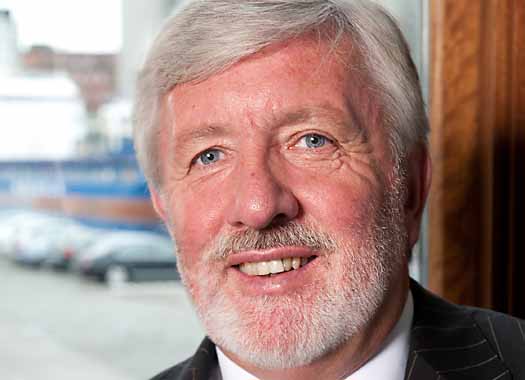
Captain Michael McCarthy is the new new chairman of industry association Cruise Europe
McCarthy thanked Moldenhauer for steering Cruise Europe through a modernization process and making it more professional and responsive to the requirements of its members. He said Cruise Europe's vision was "to deliver to the cruise companies a world class cruise destination on behalf of our members" and that he would continue working with members to promote and develop "must see" North and Atlantic European destinations.
He added: "We are facing major challenges and it is vital that Cruise Europe members support the cruise lines through greater communications and develop outstanding service while keeping costs tightly under control, particularly as the lines adapt to the Emissions Control Area regulations from 2015."
Port of Cork press release below:
PRESS RELEASE
Captain Michael McCarthy, Port of Cork, Elected as Chairman of Cruise Europe
Irish Cruise Line Business Worth an Estimated €60M to the Irish Economy
At the Cruise Europe Conference 2012 held at Royal Greenwich, London in April, Captain Michael McCarthy of the Port of Cork, was unanimously elected Chairman of Cruise Europe. Michael brings over 40 years of maritime experience to the position having served as Master at sea, Marine Surveyor, Deputy Harbour Master and is currently Commercial Manager with the Port of Cork Company.
Michael endorsed the vision of Cruise Europe which he said is "to deliver to the cruise companies a world class cruise destination on behalf of our members". Between 2005 & 2010, there has been an increase of 84% growth in the economic impact of the European Cruise Industry, bringing the total contribution to €35 billion.
On average there are over 200 cruise calls to Ireland per year carrying approximately half a million passengers and crew. This cruise business contributes an overall economic contribution estimated to be worth €60 million to the island of Ireland.
Commenting on the Irish cruise business, the newly elected chairman of Cruise Europe, Captain Michael McCarthy said: "There are many indirect economic and tourism benefits to Ireland from the cruise sector, as well as the benefit of introducing Ireland to new markets and growing business opportunities. Cruise visits help to showcase Ireland's world class shore products, destinations and highlight all that Ireland has to offer visitors."
He continued: "One of Ireland's advantages is the strategic and geographic spread of its numerous ports, many of which are in close proximity to world class tourism destinations and it is with this in mind that Ireland will be promoted with the North and Atlantic European destinations to develop thriving and "must see" destinations."
The cruise industry, as a whole, faces major challenges and it is vital that Cruise Europe members support the cruise lines through effective communications and develop an outstanding service while keeping costs tightly under control, particularly as the lines adapt to the ECA [Emissions Control Area] regulations from 2015.
"These regulations, which will come into force on January 1st 2015, will reduce sulphur limits in fuel to 0.10%. This will result in vessels operating from the English Channel through the North Sea into the Baltic from 2015, to have increased operating fuel costs of over 50%."
McCarthy also outlined the benefits of being a member of Cruise Europe and the commitment to working closely with the ECC and other representative organizations.




























